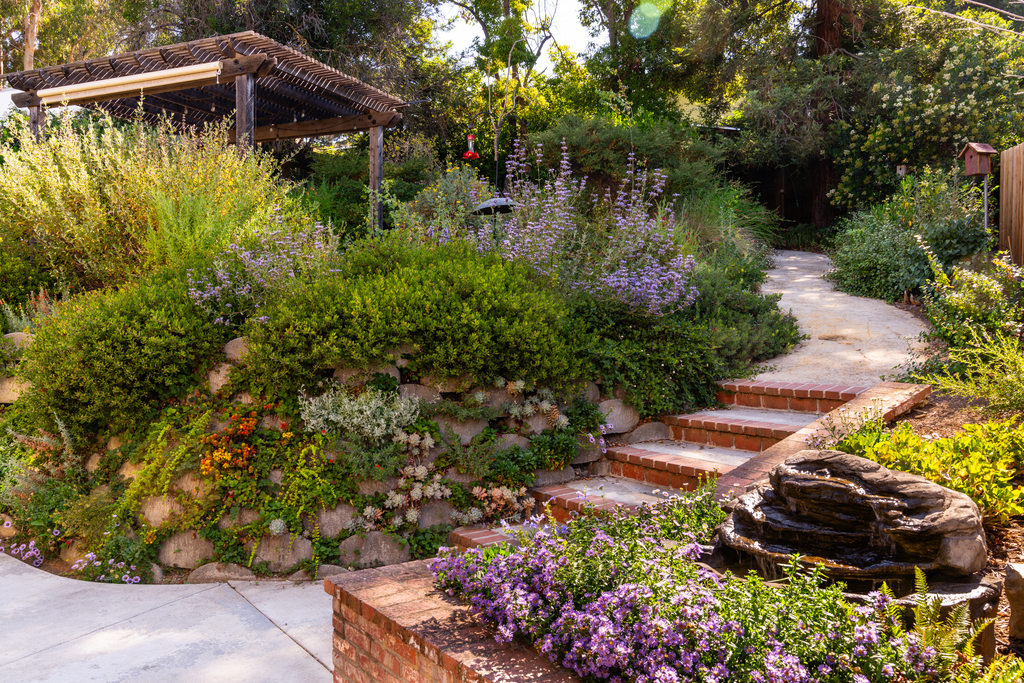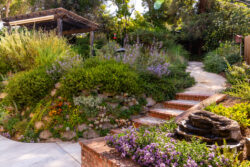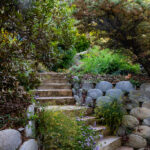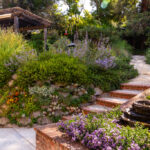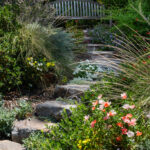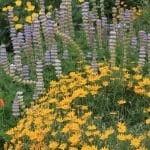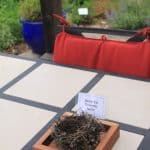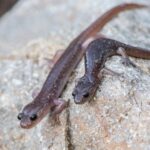When Susan and Bill’s children were small they got a lot of use out of the large lawn in the back yard. Once the kids were grown, and inspired by gardens they saw on the Bringing Back the Natives Garden Tour, Susan and Bill decided to save water, create habitat wildlife, and plant natives. Michael Thilgen and the team at Four Dimensions Landscape designed and installed this lovely garden, and EBMUD’s lawn conversion rebate program provided $2,500, which helped pay for the transformation.
- A small pond and waterfall attract wildlife as well as people. Salamanders snuggle in shady places; lizards bask on the boulders.
- Now that the garden is established it doesn’t require much water, and the drip system has been turned off. Susan waters the plants that need it by hand.
- A multitude of seating areas invite one to drop down and rest in this peaceful oasis. Go ahead and take a seat; you won’t want to leave.
No pesticides are used in this wildlife-friendly garden, which attracts a plethora of butterflies, native bees and birds. When the garden was converted, a dead apricot tree was kept to provide habitat for wildlife. Woodpeckers excavated a cavity and nested in it; nuthatches nested in the tree the next year. They were followed by chickadees—which build their nests in old woodpecker holes—before the old tree finally fell over. Last year ground-nesting spotted towhees raised their chicks under a monkeyflower. Nuthatches, wrens, thrushes, cedar waxwings and a variety of other birds have been seen in the garden.
Bill made nesting boxes for chickadees and titmice using the information on the Cornell Lab of Ornithology site here.
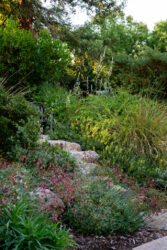 This site has great tips about the size of the holes, placement of predator guards, location and direction boxes should face, when to clean the boxes out, and more. Susan and Bill—and the chickadees and titmice that have nested in the boxes—had good success with them.
This site has great tips about the size of the holes, placement of predator guards, location and direction boxes should face, when to clean the boxes out, and more. Susan and Bill—and the chickadees and titmice that have nested in the boxes—had good success with them.
In mid-to-late summer, when the fledglings are hopping around on the ground (which they do for a week and a half to two weeks before learning to fly) Susan keeps an eye out for cats, which, according to the Smithsonian Conservation Biology Institute, kill more than two billion birds in the United States every year. (You can read more about this here.)
Bill followed the recommendations for boxes suitable for chickadees and titmice (and this works for wrens too). This site has great tips about the size of the holes, placement of predator guards, location and direction of boxes, when to clean them out, and other stuff. He followed their recommendations for boxes suitable for chickadees and titmice (and this works for wrens too). This site has great tips about the size of the holes, placement of predator guards, location and direction of boxes, when to clean them out, and other stuff. Susan reports, “These bird boxes are great, and we’ve had good success with them.”
 Birds are attracted to this garden as there is always something in bloom, the garden contains many native berry-producing plants, such as manzanita, toyon, holly leaf cherry, currants, and coffeeberry, and moving water brings them in.
Birds are attracted to this garden as there is always something in bloom, the garden contains many native berry-producing plants, such as manzanita, toyon, holly leaf cherry, currants, and coffeeberry, and moving water brings them in.
Artwork for Sale!
Unique, hand made relief prints of California native plants and animals will be available from LeafBones. Meet the artist, who will be at this garden all day!
Garden Talks
1:00 “Creating biodiversity in the native garden: exploring the design features, plant palettes and maintenance strategies that generate habitat niches and create a flourishing garden ecology” by Chris Garcia, from Four Dimensions Landscape Cooperative
Birds seen each month chart eBird Observations 2025
Photos
Click to see as a slideshow:

